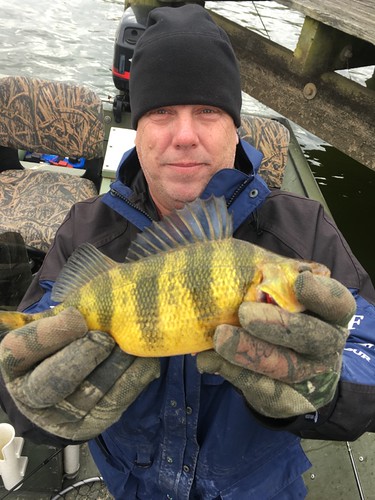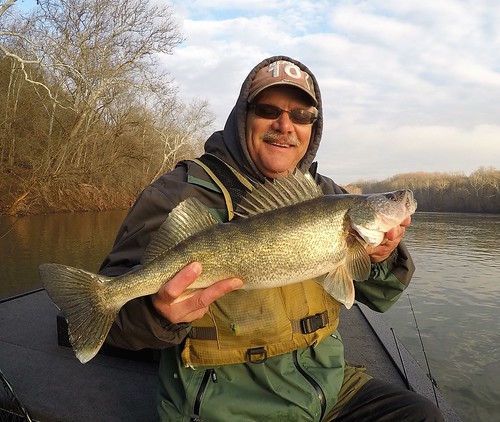By: Keith Lockwood
Mid-Winter Fishing Update
February tends to be a tough month for playing outdoors. Most hunting seasons are closed and it is a little bit early for comfortable fishing. Fortunately the trout production program and the many fisheries biologists that stock the trout have given fishermen a chance to enjoy good trout fishing in the put and take trout management waters across the entire state as part of the pre-season stocking program. It is a little early for yellow perch but those that give it a whirl are finding a few male yellow perch here and there in the tidal rivers. There are fishing shows just about every weekend this month and into March. During this time of the year, many start to think about buying a new fishing license. Remember that fishing licenses now go 365 days from the date of purchase, so check the date on your current fishing license.The lower Susquehanna River near Perryville has been offering some of the most consistent yellow perch fishing to be found right now. The typical pattern for this time of the year is that the yellow perch congregate in about 40' of water just below the Route 40 Bridge. This is vertical fishing for the most part from small boats or kayaks when weather conditions are favorable. Most prefer to use a sinker with a Christmas tree type rig with two dropper flies or small soft plastic jigs in the 1/32 oz. to 1/8 oz. size category. Tipping the lures or flies with a small piece of cut minnow or a dip in your favorite fish attractant juice can often pay better dividends.
Farther upriver and closer to the dam pool there has been some productive fishing for flathead and channel catfish. The flathead catfish tend to be in the 3lb. to 5 lb. size range in the river below the dam pool. The whopper sized flatheads tend to hold in the dam pool below the turbines where lunch consisting of mostly gizzard shad is served during power generation. In the upper, middle and lower bay regions, most anglers have their favorite places to check in the tidal rivers and creeks as they look for the vanguard of the spring yellow perch run. This usually consists of male yellow perch and a few can be found here and there at traditional locations. Water temperatures in the tidal rivers and creeks are generally in the low "forties" (40° - 44° range) right now due to a relatively mild winter. This water temperature range is relatively close to the 46° mark that will start the spawning event. The young male yellow perch want to be the first ones to show up for the party, so they are beginning to stage in deeper areas below the spawning reaches. John T. McMullen holds up a nice yellow perch for the camera.

Photo courtesy of John T. McMullen
The section of the Bush River called Gray's Run is starting to get the attention of local yellow perch fishermen as is the Wayson's Corner area on the Patuxent. There is a scattering of male yellow perch at these locations with a large portion of them being undersized. Now is the time to get your favorite tackle together. If you are a bank fisherman it is hard to beat braid for its fine diameter which helps one be able to cast a country mile. Usually a 2' piece of 4 lb. to 6 lb. fluorocarbon or mono tippet is tied on to fool the perch but also allow one to break off on those pesky submerged logs and branches that always seen to reach out grab your jig or hooked minnow. If you can come up with an educated guess on how deep the holes are that you're fishing (and yes that is where you want to be) a small 1/32 oz. soft plastic jig or hair jig under a bobber is a great way to fish. Often the bobber will need to be 4' or more above your lure or lures. If fishing this way I like the small foam type that you can slide up and down the line for adjustment; allow the light jig to sink to the proper depth and reel in slowly while giving a twitch now and then. Another way to fish is to up to a 1/16 oz. jig, a Mickey Finn type streamer fly or use a minnow with a split shot a couple of feet ahead; when fishing this way I like to keep my rod tip up high with a belly in the line and you will see it twitch in the line when a perch picks up your offering. Another tip is to not forget small shad darts, they work also whether tipped with a little piece of minnow or your favorite fish attractant juice.
Spawning runs of yellow perch and white perch are governed largely by water temperature so a warm day might spur things on and a cold day cause things to retreat. This type of fishing is often categorized by the familiar replay to how is the fishing? "Well you should have been here this morning or yesterday". It is something up to debate among fishermen but I have always placed my bets on a low flood tide during the warmth of the day. The following link will take you to our yellow perch fishing location maps on our fisheries website.
The annual winter trawl survey is just about completed on the upper bay and the lower regions of the major tidal rivers. This survey work is conducted by pulling a 25' trawl along the bottom by the research vessel RV Chesapeake to monitor resident populations of white perch, yellow perch, striped bass, catfish and forage fish such as gizzard shad. Species are sorted, measured and counted at predetermined locations the same way each year so comparisons can be evaluated. I recently was able to assist in the survey work and as one would expect this time of the year; the perch and other species were holding in deep areas at the mouths of the upper bay's tidal rivers.



Photos by Captain Mike Simonsen and Keith Lockwood
There is some deep water jigging action to be found in the deeper channel areas at the mouths of the major tidal rivers and some locations in the bay for white perch. For example there have been reports of white perch being caught in the lower Patuxent River in about 60' of water. A decent sized sinker with two dropper flies is the usual offering to get in on this early season action.
One of the most active fisheries in tidal waters this time of the year is fishing for blue catfish in the tidal Potomac River. The Fort Washington area tends to be the central location for the best fishing. This time of the year in particular is one of the best times to target trophy sized blue catfish if you're looking for a tussle. If you are looking to fill your freezer there are also plenty of medium-sized blue cats in the region. The fresher the better is the name of the game, when it comes to cut bait for blue catfish and a simple bottom rig and stout tackle is all that is needed.
The pre-season trout stocking in many "put and take" trout management areas is well under way this month and trout fishermen from the Eastern Shore to the far western regions of the state are enjoying some fun and productive fishing. These stockings offer something for everyone from those casting nymphs and wet flies with fly tackle to ultra-light spinning tackle and a pea sized piece of Powerbait on a hook. The stockings are posted as they occur on Maryland Department of Natural Resources Fisheries Facebook, on the email subscription lists, and on the trout stocking website.
Also of interest to trout fishermen are the ongoing water supply issues at the Albert Powell Trout Hatchery that will have an effect on the upcoming spring and fall trout stocking schedules. Hatchery staff are working hard to maintain and stock trout while working under tough conditions. For more information, readers can go to the following link on the Department of Natural Resources Fisheries website to learn about the situation.
Jonah Lee got to go trout fishing recently at Antietam Creek and he sure is happy with this golden rainbow trout he caught

Photo courtesy of Jonah Lee
Anglers should find some good trout fishing in Western Maryland's smaller trout streams this weekend. The weather forecast predicts sunny skies with daytime temperatures in the 50's. Last weekend the weather was warm, but stream flows were high. I fished for brook trout in a small stream within the Potomac State Forest, and had good success using a black woolly bugger fished in the deeper, slower pools.
Deep Creek Lake has no ice cover, and this weekend may be a good time to try and catch a few walleye before the season closes on March 1 through April 15. The Fisherman Access Area at the Route 219 Bridge is an excellent place to fish from shore for walleyes. Best time is right at dusk using sinking Rapalas or live shiners. I'll be there this weekend - and hopefully sharing some pictures on the Angler's Log!
Fisheries biologist John Mullican fished the upper Potomac last weekend and was kind enough to send us this report and a picture of Charlie Dolan and a fine looking upper Potomac walleye.
The Potomac River is in great shape, but a little below normal flow. River temperatures are now in the low 40s thanks to the recent warm weather and fish are becoming more active. Smallmouth bass and walleye fishing has generally been very good, though severe cold snaps can shut the action down briefly. Tubes and hair jigs are still the most reliable baits for smallmouth with suspending jerkbaits beginning to pick up some of the larger bass. Crankbaits and jigs have been getting steady attention from walleye. Due to a strong year class in 2015, most of the walleye are running between 14" - 16" though fish over 20" are still available.

Photo courtesy of John Mullican
Chain pickerel are comfortable in cold water and are eager to chase down most any offering coming their way in tidal waters or lakes and ponds. Crappie are also active but tend to be holding close to structure in deeper waters as are largemouth bass which are holding close to the bottom in the deepest waters. Small jigs or minnows will work well for crappie and the largemouth bass may be enticed to bite on blade lures or soft plastic jigs worked slowly and close to the bottom.
Fishing opportunities over near the Ocean City area are a bit sparse this time of the year with offshore tautog fishing being the best show in town. The day's success can vary from fair to good depending on the mood of the tautog and sea conditions. Surf fishermen might find a little entertainment with spiny dogfish and skates. Ocean water temperatures are holding around 45° this week.
No comments:
Post a Comment